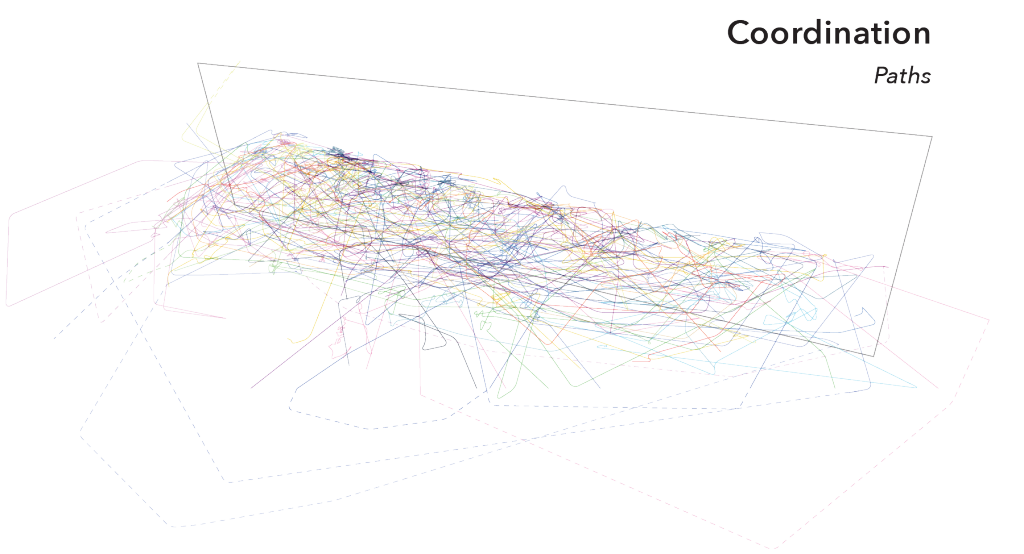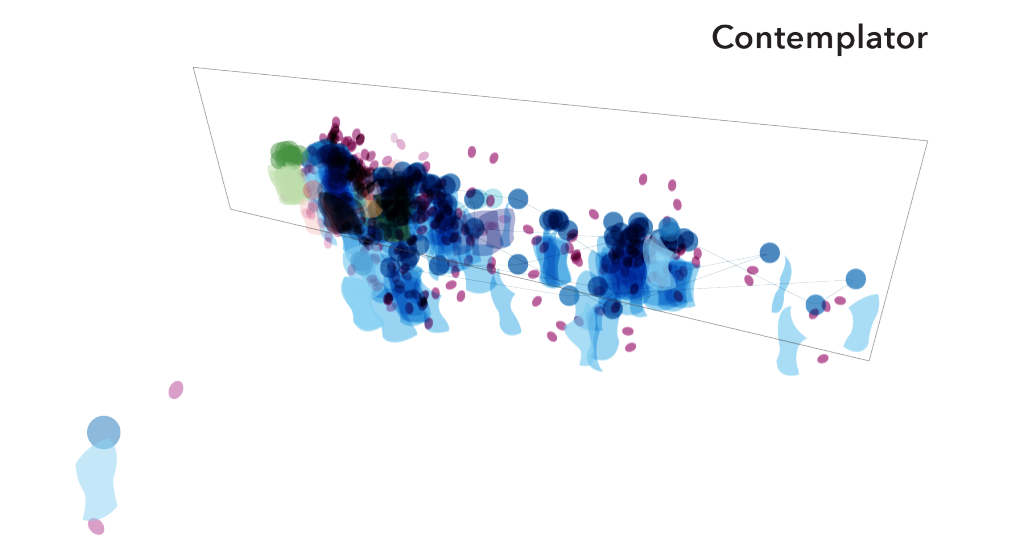Collective Intelligence

Collective Intelligence is defined as the ability of groups to solve more problems than the individuals working alone. Collective Intelligence is not just the average knowledge of the crowd, it is, rather, an emergent property that is greater than the sum of its parts. Collective Intelligence is the wisdom of the crowd. This exploration of collective intelligence examines a group of individuals working together on an affinity mapping exercise. The diagrams that follow are mappings of specific elements of the exercise that contributed to the collective intelligence of the crowd. This work was done by reviewing time lapse footage, frame by frame, and mapping the findings.
Affinity mapping is a tool designed to facilitate groups through a collective problem solving and system mapping exercise. To begin, a question is posed to a set of individuals. As individuals, they record responses to the question at hand on Post It notes. Then, as a group, participants work collectively to organize the responses into categories on the wall. The following project illustrates one specific affinity mapping exercise and is followed by an exploration and comparison between multiple affinity mapping sessions. The charrette was captured using time lapse photography, and the footage was reviewed to observe the micro-conditions that give rise to the collective intelligence that arises from this group workshop.
Reviewing the footage revealed several interesting findings. First was the identification of several different kinds of actors: Organizers, Attractors, Contributors, and Observers. Organizers focus on the Post It grouping task whereas Attractors focus on communication and information- sharing tasks. Contributors do both interacting and organizing, while Observers watch and comment on the exercise. Longer interactions occurred near the periphery of the crowd, while shorter interactions happened nearer to the wall. Lastly, three individuals were responsible for doing 41% of the organizing activity. The final affinity map is the emergent artifact that represents the collective wisdom of the group.
504 responses were organized into 25 different categories. The affinity map represents a taxonomy of the kinds of tasks, skills, and responsibilities the participants described in their everyday work. The diagram is a physical artifact generated by the collective intelligence of the group. Idea Novelty measures the uniqueness of an idea (i.e. duplicate responses do not count twice). Idea novelty is calculated as number of unique ideas over total number of ideas.

In order to complete the monumental task of organizing 504 responses into 25 categories, participants had to engage in the cooperative exercise of organising the Post Its. The accompanying diagram represents all of the instances of a participant placing or removing a Post It on the wall. Isolating the organizing pattern of a specific participant reveals the relative contribution of each individual to the organising portion of the exercise.
The final organization of the Post Its is the physical representation of the collective intelligence of the group of actors. The affinity map is an emergent product of the coordination, collaboration, and cooperation of the actors. The affinity map is a taxonomy of the kinds of activities necessary for the building design process.
Interrelationships Between Affinity Categories
The following matrix illustrates the interrelationships between the 25 categories created in this affinity mapping exercise. The goal of the exercise was to understand the different roles that employees within the firm were playing, and the resulting taxonomy of activities described the ways that employees add value to the firm and its clients. Partitioning the matrix by ordering the activities so that they follow the building development process reveals three main meta-tasks (highly coupled activities), and three bus structures (specific activities with relationships to all other activities). The first meta-task consists of the Business Development activities, while the second meta-task contains the Building Development activities. These two meta-tasks overlap at the Visualising and Planning / Programming activities, pointing to an important hand-off in the design process. The third meta-task couples the activities related to firm culture illustrating the importance of design in the organization.
The primary drivers in the system are those activities that have affecting relationships with the greatest number of other activities. In this case Designing and Leading Teams and the most important activities contributing to the overall building development process. Designing also happens to be a key effect in the system, demonstrating how each of the activities involved in the building development process have the opportunity to affect design. The second key effect in the system is Making Money. This column illustrates all of the actives that might contribute to making (or losing) money on a project. Highly coupled with the activity of Making Money is Negotiating, emphasising the importance of negotiation to the revenue stream for the design and delivery of complex building systems.
Animations of the Paths and Contributions of Kinds of Actors










